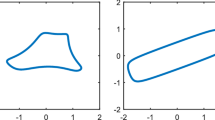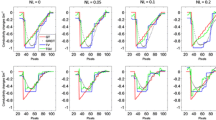Abstract
This paper addresses the challenge of reconstructing multiphase conductivity distributions using electrical impedance tomography (EIT). The reconstruction method developed in the paper utilizes the moving morphable component (MMC) approach, where the unknown inclusion(s) to be reconstructed is (are) composed of several candidate morphable components. This work introduces a signed distance-based shape and topology description function (STDF) in lieu of the recently developed hyperelliptic STDF in the MMC approach, thereby absolving the requirement of exponent values. The MMC approach uses explicit geometric entities for the morphable components that are controlled by geometric parameters, such as varying thickness, length, and angle. The optimal inclusion shapes are found by optimizing these geometric parameters in STDFs. Numerical simulation and water tank experiments are used to demonstrate the effectiveness of the proposed method.










Similar content being viewed by others
Notes
The derivatives of fs with respect to shape design variables can be found using Symbolic Math Toolbox™software.
References
Adler A, Boyle A (2017) Electrical impedance tomography: Tissue properties to image measures. IEEE Trans Biomed Eng 64(11):2494–2504
Al Hosani E, Soleimani M (2016) Multiphase permittivity imaging using absolute value electrical capacitance tomography data and a level set algorithm. Phil Trans R Soc A 374(2070):20150332
Albuquerque YF, Laurain A, Sturm K (2020) A shape optimization approach for electrical impedance tomography with point measurements. Inverse Problems 36(9):095006
Ammari H, Garnier J, Kang H, Lim M, Yu S (2014) Generalized polarization tensors for shape description. Numer Math 126(2):199–224
Barber DC, Brown BH (1984) Applied potential tomography. J Phys E Scientif Instrument 17(9):723–733
Beretta E, Micheletti S, Perotto S, Santacesaria M (2018) Reconstruction of a piecewise constant conductivity on a polygonal partition via shape optimization in EIT. J Comput Phys 353:264–280
de Castro Martins T, Sato AK, de Moura FS, de Camargo EDLB, Silva OL, Santos TBR, Zhao Z, Möeller K, Amato MBP, Mueller JL et al (2019) A review of electrical impedance tomography in lung applications: theory and algorithms for absolute images. Annual Reviews in Control
Chen X (2018) Computational methods for electromagnetic inverse scattering. Wiley, Hoboken
Coniglio S, Morlier J, Gogu C, Amargier R (2019) Generalized geometry projection: a unified approach for geometric feature based topology optimization. Arch Comput Methods Eng 1–38
Costa EL, Chaves CN, Gomes S, Beraldo MA, Volpe MS, Tucci MR, Schettino IA, Bohm SH, Carvalho CR, Tanaka H et al (2008) Real-time detection of pneumothorax using electrical impedance tomography. Crit Care Med 36(4):1230–1238
Fang W (2007) Multi-phase permittivity reconstruction in electrical capacitance tomography by level-set methods. Inverse Problems in Sci Eng 15(3):213–247
González G, Huttunen J, Kolehmainen V, Seppänen A, Vauhkonen M (2016) Experimental evaluation of 3d electrical impedance tomography with total variation prior. Inverse Problems Sci Eng 24(8):1411–1431
González G, Kolehmainen V, Seppänen A (2017) Isotropic and anisotropic total variation regularization in electrical impedance tomography. Comput Math Appl 74(3):564–576
Gu D, Liu D, Smyl D, Deng J, Du J (2021) Supershape recovery from electrical impedance tomography data. IEEE Trans Instrument Measure 70:1–11. https://doi.org/10.1109/TIM.2021.3064802
Guo X, Zhang W, Zhong W (2014) Doing topology optimization explicitly and geometrically—a new moving morphable components based framework. J Appl Mechan 81(8):081009
Guo X, Zhang W, Zhang J, Yuan J (2016) Explicit structural topology optimization based on moving morphable components (MMC) with curved skeletons. Comput Methods Appl Mech Eng 310:711–748
Hamilton SJ, Hauptmann A (2018) Deep d-bar: real time electrical impedance tomography imaging with deep neural networks. IEEE Trans Med Imaging 37(10):2367–2377
Hamilton SJ, Reyes JM, Siltanen S, Zhang X (2016) A hybrid segmentation and d-bar method for electrical impedance tomography. SIAM J Imaging Sci 9(2):770–793
Harrach B, Ullrich M (2013) Monotonicity-based shape reconstruction in electrical impedance tomography. SIAM J Math Anal 45(6):3382–3403
Hiles A, Dorn O (2020) Colour level set regularization for the electromagnetic imaging of highly discontinuous parameters in 3d. Inverse Problems Sci Eng 1–36
Hintermüller M, Laurain A (2008) Electrical impedance tomography: from topology to shape. Control Cybern 37(4)
Hintermüller M, Laurain A, Novotny AA (2012) Second-order topological expansion for electrical impedance tomography. Adv Comput Math 36(2):235–265
Hoang VN, Jang GW (2017) Topology optimization using moving morphable bars for versatile thickness control. Comput Methods Appl Mech Eng 317:153–173
Kourunen J, Savolainen T, Lehikoinen A, Vauhkonen M, Heikkinen L (2009) Suitability of a pxi platform for an electrical impedance tomography system. Measure Sci Technol 20(1):015503
Laurain A, Sturm K (2016) Distributed shape derivative via averaged adjoint method and applications. ESAIM Math Model Numer Anal 50(4):1241–1267
Li S, Montcel B, Yuan Z, Liu W, Vray D (2015) Multigrid-based reconstruction algorithm for quantitative photoacoustic tomography. Biomed Opt Express 6(7):2424–2434
Lian R, Jing S, He Z, Shi Z, Song G (2020) An accelerating convergence rate method for moving morphable components. Math Probl Eng 2020
Lieberman C, Willcox K, Ghattas O (2010) Parameter and state model reduction for large-scale statistical inverse problems. SIAM J Sci Comput 32:2523–2542
Liu D, Du J (2019) A moving morphable components based shape reconstruction framework for electrical impedance tomography. IEEE Trans Med Imaging 38(12):2937–2948
Liu D, Khambampati AK, Kim S, Kim KY (2015) Multi-phase flow monitoring with electrical impedance tomography using level set based method. Nucl Eng Des 289:108–116
Liu D, Khambampati AK, Du J (2018a) A parametric level set method for electrical impedance tomography. IEEE Trans Med Imaging 37(2):451–460. https://doi.org/10.1109/TMI.2017.2756078
Liu D, Zhao Y, Khambampati AK, Seppanen A, Du J (2018b) A parametric level set method for imaging multi-phase conductivity using electrical impedance tomography. IEEE Trans Comput Imaging 4(4):552–561. https://doi.org/10.1109/TCI.2018.2863038
Liu D, Gu D, Smyl D, Deng J, Du J (2019) B-spline-based sharp feature preserving shape reconstruction approach for electrical impedance tomography. IEEE Trans Med Imaging 38:2533–2544
Liu D, Gu D, Smyl D, Deng J, Du J (2020a) B-spline level set method for shape reconstruction in electrical impedance tomography. IEEE Trans Med Imaging 39(6):1917–1929
Liu D, Gu D, Smyl D, Deng J, Du J (2020b) Multiphase conductivity imaging with electrical impedance tomography and b-spline level set method. IEEE Trans Instrum Meas 69(12):9634–9644
Liu D, Gu D, Smyl D, Deng J, Du J (2020c) Shape reconstruction using boolean operations in electrical impedance tomography. IEEE Trans Med Imaging 39(9):2954–2964
Liu D, Gu D, Smyl D, Khambampati AK, Deng J, Du J (2020d) Shape-driven eit reconstruction using fourier representations. IEEE Trans Med Imaging 40(2):481–490
Liu D, Smyl D, Du J (2020e) Nonstationary shape estimation in electrical impedance tomography using a parametric level set-based extended kalman filter approach. IEEE Trans Instrum Meas 69(5):1894–1907
Liu D, Smyl D, Gu D, Du J (2020f) Shape-driven difference electrical impedance tomography. IEEE Trans Med Imaging 39(12):3801–3812
Ma Y, Miao L, Qin H, Chen X, Xiong X, Han T, Qin P, Ji X, Cai P (2018) A new modular semi-parallel eit system for medical application. Biomed Signal Process Cont 39:416–423
Mei Y, Du Z, Zhao D, Zhang W, Liu C, Guo X (2021) Moving morphable inclusion approach: an explicit framework to solve inverse problem in elasticity. J Appl Mech 88(4)
Mueller JL, Siltanen S (2020) The D-bar method for electrical impedance tomography—demystified. Inverse Problems
Nissinen A, Kolehmainen VP, Kaipio JP (2011) Compensation of modelling errors due to unknown domain boundary in electrical impedance tomography. IEEE Trans Med Imaging 30(2):231– 242
Ren S, Wang Y, Liang G, Dong F (2018) A robust inclusion boundary reconstructor for electrical impedance tomography with geometric constraints. IEEE Trans Instrum Meas 68(3):762–773
Ren S, Sun K, Liu D, Dong F (2019) A statistical shape-constrained reconstruction framework for electrical impedance tomography. IEEE Trans Med Imaging 38(10):2400–2410
Samorè A, Guermandi M, Placati S, Guerrieri R (2017) Parametric detection and classification of compact conductivity contrasts with electrical impedance tomography. IEEE Trans Instrum Meas 66 (10):2666–2679
Sorkine O, Cohen-Or D, Irony D, Toledo S (2005) Geometry-aware bases for shape approximation. IEEE Trans Visual Comput Graph 11(2):171–180
Tan C, Lv S, Dong F, Takei M (2019) Image reconstruction based on convolutional neural network for electrical resistance tomography. IEEE Sensors J 19(1):196–204
Tian W, Suo P, Liu D, Sun S, Sun J, Xu L (2021) Simultaneous shape and permittivity reconstruction in ECT with sparse representation: two-phase distribution imaging. IEEE Trans Instrum Meas 70:1–14
Vauhkonen M, Vadasz D, Karjalainen PA, Somersalo E, Kaipio JP (1998) Tikhonov regularization and prior information in electrical impedance tomography. IEEE Trans Med Imaging 17(2):285– 293
Vauhkonen P, Vauhkonen M, Savolainen T, Kaipio J (1999) Three-dimensional electrical impedance tomography based on the complete electrode model. IEEE Trans Biomed Eng 46:1150–1160
Vese LA, Chan TF (2002) A multiphase level set framework for image segmentation using the mumford and shah model. Int J Comput Vision 50(3):271–293
Wang Z, Bovik AC, Sheikh HR, Simoncelli EP (2004) Image quality assessment: from error visibility to structural similarity. IEEE Trans Image Process 13(4):600–612
Xiao Z, Tan C, Dong F (2019) 3-d hemorrhage imaging by cambered magnetic induction tomography. IEEE Trans Instrument Measure 68(7):2460–2468
Yao J, Takei M (2017) Application of process tomography to multiphase flow measurement in industrial and biomedical fields-a review. IEEE Sensors Journal
Zhang S, Norato JA, Gain AL, Lyu N (2016a) A geometry projection method for the topology optimization of plate structures. Struct Multidiscip Optim 54(5):1173–1190
Zhang W, Yuan J, Zhang J, Guo X (2016b) A new topology optimization approach based on moving morphable components (MMC) and the ersatz material model. Struct Multidiscip Optim 53 (6):1243–1260
Zhang W, Song J, Zhou J, Du Z, Zhu Y, Sun Z, Guo X (2018) Topology optimization with multiple materials via moving morphable component (MMC) method. Int J Numer Methods Eng 113 (11):1653–1675
Acknowledgements
The authors would like to thank Danny Smyl, PhD for the helpful discussions. Also, the authors would like to thank the inverse problems group at University of Eastern Finland for providing us with the experimental data.
Funding
This work was supported in part by the National Natural Science Foundation of China (Grant Nos. 61871356 and 81788101), in part by the National Key R&D Program of China (Grant No. 2018YFA0306600), in part by the Chinese Academy of Sciences (Grant Nos. XDC07040200, GJJSTD20170001, and QYZDY-SSW-SLH004), and in part by the Anhui Initiative in Quantum Information Technologies (Grant No. AHY050000).
Author information
Authors and Affiliations
Corresponding author
Ethics declarations
Consent for publication
We would like to declare that the work described was original research that has not been published previously, and not under consideration for publication elsewhere, in whole or in part.
Conflict of interest
The authors declare that they have no conflict of interest.
Additional information
Responsible Editor: Anton Evgrafov
Replication of results
To perform replication of the results presented in this paper, all parameter settings and implementation aspects have been described in detail in the paper. If the information provided in the paper is not sufficient, interested readers are welcome to contact the authors for further explanations.
Publisher’s note
Springer Nature remains neutral with regard to jurisdictional claims in published maps and institutional affiliations.
Rights and permissions
About this article
Cite this article
Liu, D., Du, J. Shape and topology optimization in electrical impedance tomography via moving morphable components method. Struct Multidisc Optim 64, 585–598 (2021). https://doi.org/10.1007/s00158-021-02970-8
Received:
Revised:
Accepted:
Published:
Issue Date:
DOI: https://doi.org/10.1007/s00158-021-02970-8




